EGM Advertisement: Sell Famiclones, Go to Prison
Friday, February 17th, 2006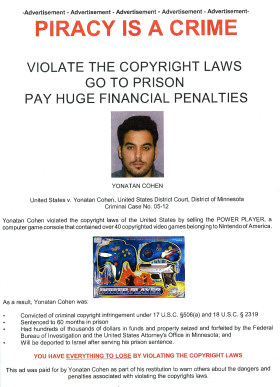

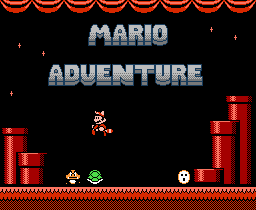 Just yesterday I had the opportunity to conduct an email interview DahrkDaiz, creator of the impressive hack Mario Adventure. Mario Adventure is a completely new Mario game made from modifications to the Super Mario Bros. 3 game engine for the NES. The game was the subject of a recent piece on VC&G and has proven to be quite popular now that it has been given wider attention on our site.
Just yesterday I had the opportunity to conduct an email interview DahrkDaiz, creator of the impressive hack Mario Adventure. Mario Adventure is a completely new Mario game made from modifications to the Super Mario Bros. 3 game engine for the NES. The game was the subject of a recent piece on VC&G and has proven to be quite popular now that it has been given wider attention on our site.
Vintage Computing and Gaming: Thank you for agreeing to this interview. First off, where are you from?
DahrkDaiz: Knoxville, Tennessee
VC&G: What do you do for a living?
DD: I’m currently a student at ITT-Tech and working full time at a fast food restaurant.
VC&G: Do you aspire to be a professional game designer?
DD: I hope so one day but in reality I know game design is a tough field to crack, so I’ll continue to pursue the dream in my spare time while focusing on a realistic programming career, working for businesses to make a living.
VC&G: What’s your favorite video game? Favorite Mario game?
DD: A tie between Sonic 3 & Knuckles and SMB3. [Favorite Mario Game:] SMB3, no surprise there.
VC&G: What inspired you to make Mario Adventure?
DD: The total lack of a proper Mario sequel. I was disappointed with the Mario Advance series and I saw other people’s attempt at creating a new SMB3 experience and decided to take the matter into my own hands.
VC&G: Mario Adventure has been very popular on VC&G. It been downloaded over 11,000 times from our site in the last few days. Is there anything you’d like the players of Mario Adventure to know or keep in mind while playing?
DD: This hack was made with the hardcore SMB3 player in mind. I could practically beat the original with my eyes closed and figured it was time to up the difficulty. However, I tried to include ways to pass hard obstacles easily. Use your power-ups to their fullest abilities and you should do fine getting through the game.
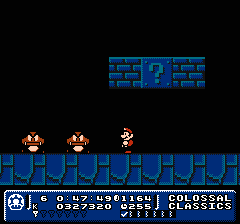 VC&G: What’s your favorite new feature of Mario Adventure? Also, what’s your favorite world in the game?
VC&G: What’s your favorite new feature of Mario Adventure? Also, what’s your favorite world in the game?
DD: Definitely the key collecting idea. I always liked having to back track through levels or world to get something out of the way to continue in a game. Point A to point B grows old quickly. [Favorite World:] Colossal Classics. The giant nostalgic look just has something about it that pleases me. Though I thought I could have a slightly better job with it.
VC&G: What development tools did you use to create Mario Adventure?
DD: FCEUd (emulator with an excellent debugger), YY-Chr (graphics editing), Mario 3 Improvement (archaic SMB3 level editor), Hex Workshop (hex editor).
VC&G: How long did it take you to complete Mario Adventuree?
DD: Approximately 16 months.
VC&G: Was reverse engineering the Super Mario Bros. 3 Game engine and implementing new rules, power-ups, etc. difficult? Tell us more about how you made changes to the Super Mario Bros. 3 game itself.
DD: At first it was very difficult. I slowly began to see a certain logic used behind the game. However, when reprogramming the code, I had to find unused space in the ROM, so that was pretty much hit and miss. Admittedly I did a poor job at coding it, hence all the bugs and glitches, but I did what I could with what knowledge I knew. A lot of time stepping through code and even writing code out on paper while at work during my break was required.
VC&G: Did you do all the level design in Mario Adventure yourself?
DD: Absolutely everything was done by me in this.
VC&G: Do you think Mario Adventure would work properly if somehow put on an actual hardware cartridge and played on a real NES/Famicom? Have you ever attempted this?
DD: Unfortunately, it will not. I reprogrammed the game to take advantage of a bug most emulators have, however, I did not realize at the time that it was a bug. The hack would work on a real NES, but not properly all time. The main bug being the status bar moving up over the screen at certain times.
VC&G: Have you ever heard from Nintendo about your Mario hacking exploits?
DD: Surprisingly, no.
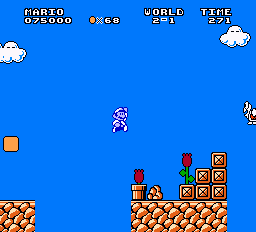 VC&G: Have you done any previous game hacking projects? If so, tell us about them.
VC&G: Have you done any previous game hacking projects? If so, tell us about them.
DD: Before Mario Adventure? No, but there were a few things I did while working on Mario Adventure and afterwards. Most of it is unknown unfinished test projects. I created a cool parallax (SNES style) background scroll in Mega Man 3 for Snake Man’s stage. I hacked Castlevania 3 to start and stay as Alucard. I completely hacked Ms. Pac-Man to have 32 unique levels, a mode to play levels at random and a pellet counter. This hack is known as Pac-Man 3 and will be available on my site once it relaunches.
VC&G: What can you tell us about your next hacking project? When will it be ready?
DD: I can tell you now the next big project is another SMB3 hack. Most people may sigh at this, but I took a different approach with this hack and differs from Mario Adventure. The scale is that, if not more than Mario Adventure. It makes Luigi and Mario be separate characters with each having special powers of their own for different gameplay, including Luigi’s floaty jump and slippery control and a new item box for Mario found in Mario Adventure. Each character has their own separate 8 worlds to play through, so this is literally two hacks in one. It’s like nothing you’ve ever seen.
VC&G: Is there anything else that you’d like our readers to know?
DD: Mario Adventure is a real gem, but I’ve listened to a lot of good and bad feedback on it and this new project I’m working on addresses those issues. But I like to thank everyone who’s played this hack and given so much praise for it. It’s really inspired me to take game development as a serious career.

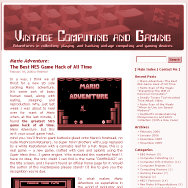 This is just a quick note that I’ll probably expand later, but I’m currently looking for writers who might like to contribute articles to this “blogazine,” Vintage Computing and Gaming. If you have a passion for old computers or video games and like to write, then you’d be a great candidate. Of course, it’s not a paying job…I don’t get paid and I run the place. It’s a labor of love — for enthusiasts, by enthusiasts. If you have any unique ideas or insights about computers or gaming (especially the vintage kind) that you’ve always wanted to share with the world, now’s your chance. If you’re interested, email me and we’ll talk. Thanks!
This is just a quick note that I’ll probably expand later, but I’m currently looking for writers who might like to contribute articles to this “blogazine,” Vintage Computing and Gaming. If you have a passion for old computers or video games and like to write, then you’d be a great candidate. Of course, it’s not a paying job…I don’t get paid and I run the place. It’s a labor of love — for enthusiasts, by enthusiasts. If you have any unique ideas or insights about computers or gaming (especially the vintage kind) that you’ve always wanted to share with the world, now’s your chance. If you’re interested, email me and we’ll talk. Thanks!
 In a way, I think we all thirst for a new 2D side scrolling Mario adventure. It’s some sort of basic human need, along with eating, sleeping and reproduction. Why, just last week I was about to keel over for want of Mario when, at the last minute, I found the greatest NES game hack of all time, Mario Adventure. But this isn’t your usual game hack, mind you. You’ll find no giant buttocks glued onto Mario’s forehead, no nude Mushroom Retainers, no Super Tokin’ Brothers with Luigi replaced by a white Rastafarian with a cannabis leaf for a hat. Nope, this is a real game — a new game, crafted with care and aplomb using the Super Mario Bros. 3 game engine. Who executed this masterful feat? Look no further than intrepid homebrew coder “DahrkDaiz,” who completed the game over the course of sixteen months, sometimes coding on paper during his breaks while working at a fast food restaurant (check out our interview with Mario Adventure’s creator here). Now that’s what I call dedication. This man deserves serious recognition for the creation of this masterpiece.
In a way, I think we all thirst for a new 2D side scrolling Mario adventure. It’s some sort of basic human need, along with eating, sleeping and reproduction. Why, just last week I was about to keel over for want of Mario when, at the last minute, I found the greatest NES game hack of all time, Mario Adventure. But this isn’t your usual game hack, mind you. You’ll find no giant buttocks glued onto Mario’s forehead, no nude Mushroom Retainers, no Super Tokin’ Brothers with Luigi replaced by a white Rastafarian with a cannabis leaf for a hat. Nope, this is a real game — a new game, crafted with care and aplomb using the Super Mario Bros. 3 game engine. Who executed this masterful feat? Look no further than intrepid homebrew coder “DahrkDaiz,” who completed the game over the course of sixteen months, sometimes coding on paper during his breaks while working at a fast food restaurant (check out our interview with Mario Adventure’s creator here). Now that’s what I call dedication. This man deserves serious recognition for the creation of this masterpiece.
[ Continue reading Mario Adventure: The Best NES Game Hack of All Time » ]

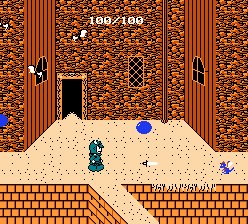 This is sort of a follow up to my last feature on Deadly Towers. I stumbled upon this speed run video (78 mb, requires Xvid codec) of a guy beating said game in 18 minutes and 46 seconds on the site NES Videos (scroll down to Deadly Towers on that page). NES Videos is a cool archive of tool-assisted console game movies. What are tool-assisted game movies, you ask? Well, they are attempts to find the quickest possible way to complete a game, but they use emulator save states to achieve as perfect as possible a performance, and clever video editing to present a seamless viewing experience (making it appear that the entire run was done in one sitting). Ideally, I suppose the time-attack competitors that make these movies are looking for the theoretical “best” or “fastest” way to complete a given video game, sometimes with different constraints. They’re lots of fun to watch, so check out some more on the NES Videos site.
This is sort of a follow up to my last feature on Deadly Towers. I stumbled upon this speed run video (78 mb, requires Xvid codec) of a guy beating said game in 18 minutes and 46 seconds on the site NES Videos (scroll down to Deadly Towers on that page). NES Videos is a cool archive of tool-assisted console game movies. What are tool-assisted game movies, you ask? Well, they are attempts to find the quickest possible way to complete a game, but they use emulator save states to achieve as perfect as possible a performance, and clever video editing to present a seamless viewing experience (making it appear that the entire run was done in one sitting). Ideally, I suppose the time-attack competitors that make these movies are looking for the theoretical “best” or “fastest” way to complete a given video game, sometimes with different constraints. They’re lots of fun to watch, so check out some more on the NES Videos site.
Anyway, as I mentioned before, all the dungeons that Ben Johnson mapped (presented in our last article) are completely superfluous to successful Deadly Towers completion. And as a great illustration of this fact, the player in the video doesn’t enter any one of them at all. This video makes it look like DT is way easier than it is. But give it a play yourself and get frustrated / mystified like the rest of us.
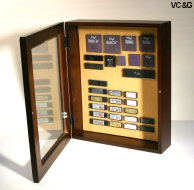 Apologies for the lack of updates recently. Alas, life surely gets in the way when you’re running a free “blogazine” in your spare time. Some ambitious articles are in the works, so stay tuned. Meanwhile, I’ve been meaning to share this with VC&G readers for months: it’s my somewhat underwhelming microprocessor and PC BIOS collection. Why underwhelming? Because it’s composed mostly of easy to find x86-compatible processors so far. I am almost more proud of the case than its contents at the moment (cases like the one pictured can be had cheaply at places like Target or craft stores for around $12-$15 US). I could add some more interesting CPUs if I was willing to rip the brains out of my old computers (which, in general, I’m not). But I do have something like six nasty C-64s sitting around, so I should at least add a 6510 to my collection. My favorite part is the 64-pin Motorola 68000 chip that I painstakingly de-soldered from a surplus Mac Plus motherboard some years ago. I’ve always wanted one of those loose because of their unique package size (not among 68000s, but among DIPs in general).
Apologies for the lack of updates recently. Alas, life surely gets in the way when you’re running a free “blogazine” in your spare time. Some ambitious articles are in the works, so stay tuned. Meanwhile, I’ve been meaning to share this with VC&G readers for months: it’s my somewhat underwhelming microprocessor and PC BIOS collection. Why underwhelming? Because it’s composed mostly of easy to find x86-compatible processors so far. I am almost more proud of the case than its contents at the moment (cases like the one pictured can be had cheaply at places like Target or craft stores for around $12-$15 US). I could add some more interesting CPUs if I was willing to rip the brains out of my old computers (which, in general, I’m not). But I do have something like six nasty C-64s sitting around, so I should at least add a 6510 to my collection. My favorite part is the 64-pin Motorola 68000 chip that I painstakingly de-soldered from a surplus Mac Plus motherboard some years ago. I’ve always wanted one of those loose because of their unique package size (not among 68000s, but among DIPs in general).
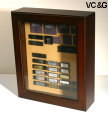 So far in my collection I have the following (from left to right, top to bottom): Intel A80486SX-25, Intel A80486DX-33, Intel A80386DX-25 (x2), Intel P8080A, Intel D80287-10 (co-processor), IIT 3C87-40 (386 clone, I think), Intel R80286-10, Intel CG80286-8, Intel A80387DX-25 (co-prossesor), Motorola MC68000P8. Then I have a bunch of different PC BIOS chips that aren’t all that amazing — the only notable ones are the Phoenix 3.10 chips, and the Mac Plus ROMs (which obviously aren’t BIOSes, but I don’t know where else to put them).
So far in my collection I have the following (from left to right, top to bottom): Intel A80486SX-25, Intel A80486DX-33, Intel A80386DX-25 (x2), Intel P8080A, Intel D80287-10 (co-processor), IIT 3C87-40 (386 clone, I think), Intel R80286-10, Intel CG80286-8, Intel A80387DX-25 (co-prossesor), Motorola MC68000P8. Then I have a bunch of different PC BIOS chips that aren’t all that amazing — the only notable ones are the Phoenix 3.10 chips, and the Mac Plus ROMs (which obviously aren’t BIOSes, but I don’t know where else to put them).
If anybody wants to donate some CPUs to the VC&G Microprocessor collection, let me know. 
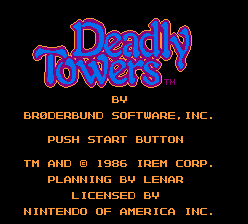 The game Deadly Towers for the NES has always held a special place of mystery and fascination in the minds of both myself and a close friend of mine. I remember playing it while I was sick from school long ago, and, believe it or not, being completely immersed in the atmosphere of the game. I now suspect that the game’s intriguing intro music had much to do with it, giving the game a much more epic feel in my mind than actually exists on cartridge. Also, I was always mystified by the myriad small black windows on the tower backgrounds, which always made want to peek inside and see what was in there.
The game Deadly Towers for the NES has always held a special place of mystery and fascination in the minds of both myself and a close friend of mine. I remember playing it while I was sick from school long ago, and, believe it or not, being completely immersed in the atmosphere of the game. I now suspect that the game’s intriguing intro music had much to do with it, giving the game a much more epic feel in my mind than actually exists on cartridge. Also, I was always mystified by the myriad small black windows on the tower backgrounds, which always made want to peek inside and see what was in there.
 My overwhelming nostalgic love for the game is kinda funny because, years later, upon seeing if there were any fan sites for Deadly Towers, I realized that everyone other than me and my friend seems to utterly hate this game. In fact, the ever-colorful Seanbaby said it was the #1 worst NES game of all time on his site. Wow. I definitely wouldn’t go that far (but of course, Seanbaby always goes as far as he can — he probably wipes his butt with Deadly Towers cartridges…just because he can). But make no mistake: Deadly Towers is no gem, either. One of the reasons it is loathed by many is that it is insanely frustrating and difficult. Some of the first enemies you encounter in the game require you to stand in the same spot for a minute, hitting them about fifty times with your wimpy starting sword to kill them. Most of us who played it at all would have killed ourselves long ago if not for the famous “EF or FE Code” (thank you, Nintendo Power) that gives you one of the bells pre-burned and the best armor and weapons (To use the code, start the game, die, then add “EF” or “FE” to the start of your password). Using that trick, the game actually becomes bearable to play for someone who’s not swimming in mystical nostalgia.
My overwhelming nostalgic love for the game is kinda funny because, years later, upon seeing if there were any fan sites for Deadly Towers, I realized that everyone other than me and my friend seems to utterly hate this game. In fact, the ever-colorful Seanbaby said it was the #1 worst NES game of all time on his site. Wow. I definitely wouldn’t go that far (but of course, Seanbaby always goes as far as he can — he probably wipes his butt with Deadly Towers cartridges…just because he can). But make no mistake: Deadly Towers is no gem, either. One of the reasons it is loathed by many is that it is insanely frustrating and difficult. Some of the first enemies you encounter in the game require you to stand in the same spot for a minute, hitting them about fifty times with your wimpy starting sword to kill them. Most of us who played it at all would have killed ourselves long ago if not for the famous “EF or FE Code” (thank you, Nintendo Power) that gives you one of the bells pre-burned and the best armor and weapons (To use the code, start the game, die, then add “EF” or “FE” to the start of your password). Using that trick, the game actually becomes bearable to play for someone who’s not swimming in mystical nostalgia.
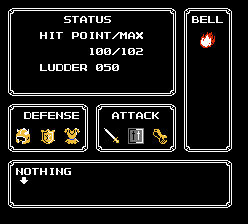 So imagine my surprise when, back in 2003, my best friend called me up and announced that he was going to beat Deadly Towers — without cheating. “Gasp! Are you insane, man?!” I stumbled, almost dropping the phone as I fell from my chair. No, he replied…he took it as a challenge — a challenge to his gaming might, endurance, and ability. He wanted to be one of the twelve people in the world to actually complete the game as intended (ten of which are former Japanese grade-schoolers, no doubt, who seem to have a sadistic drive to consume even the most insanely difficult games). With no strategy guides or maps available to guide him, not even on our precious Internet (save for the 1st dungeon map in the manual), he set out on his mission. I set out along with him, playing it simultaneously as we talked on the phone, but I eventually gave up half-way through. It was just too tedious for me. Over the next month, he not only completed the game entirely, but mapped all of its completely useless dungeons (which you don’t even have to enter to beat the game), and found most, if not all, of the secret exits in the towers, which contain special weapon upgrades and the like.
So imagine my surprise when, back in 2003, my best friend called me up and announced that he was going to beat Deadly Towers — without cheating. “Gasp! Are you insane, man?!” I stumbled, almost dropping the phone as I fell from my chair. No, he replied…he took it as a challenge — a challenge to his gaming might, endurance, and ability. He wanted to be one of the twelve people in the world to actually complete the game as intended (ten of which are former Japanese grade-schoolers, no doubt, who seem to have a sadistic drive to consume even the most insanely difficult games). With no strategy guides or maps available to guide him, not even on our precious Internet (save for the 1st dungeon map in the manual), he set out on his mission. I set out along with him, playing it simultaneously as we talked on the phone, but I eventually gave up half-way through. It was just too tedious for me. Over the next month, he not only completed the game entirely, but mapped all of its completely useless dungeons (which you don’t even have to enter to beat the game), and found most, if not all, of the secret exits in the towers, which contain special weapon upgrades and the like.
So without further delay, I present to you, published for the first time ever on the Internet (in English, anyway), The Secret Maps of Deadly Towers [cue mind-blowing music]. And what’s more, instead of spending countless hours transcribing them into some legible computerized format, I am presenting them in the artist’s original hand, for extra charm and authenticity. Their format might also give you more of an idea as to what an epic accomplishment this really is. The intrepid artist’s name? Ben Johnson. From now on, let these be known as The Johnson Maps.
Yep, those were the days: when we all had to make our game maps by hand.
How come there’s no “Dungeon A” map, you ask? Because it’s already mapped in the Deadly Towers manual. Oh, and the maps are in Adobe Acrobat PDF format for easy printing (didn’t want you to have to fiddle with printing letter-sized JPEGs, you know).
If anyone else actually likes this game, speak now, or forever will Deadly Towers roast in the pits of Internet game-punditry hell!